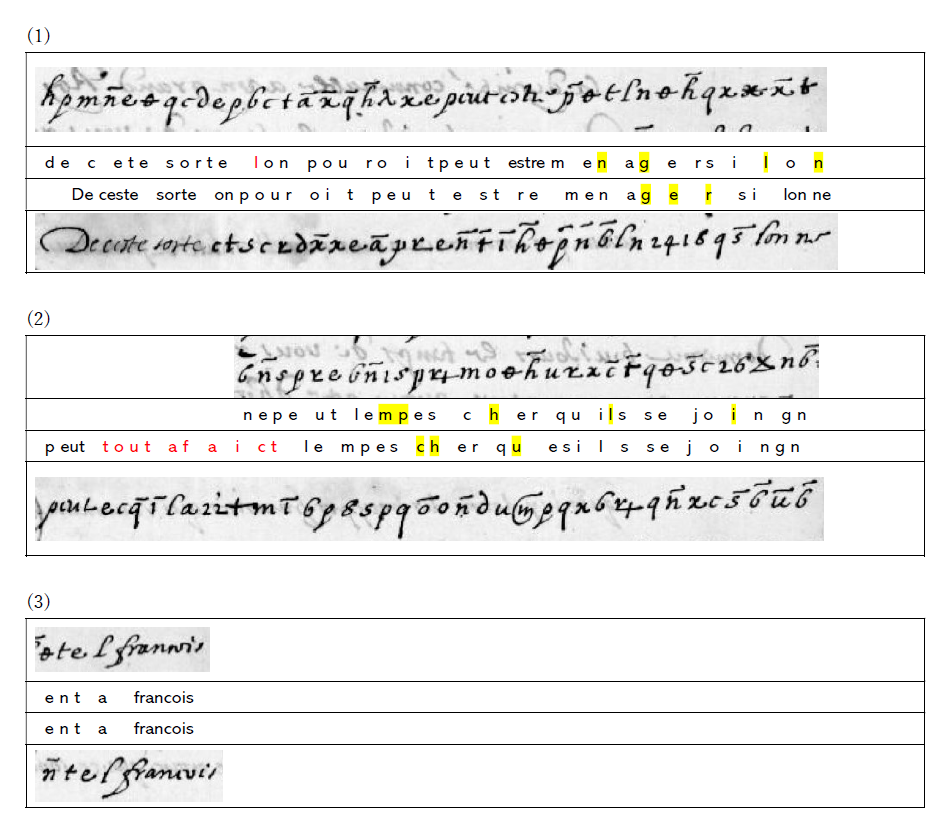François Viète said one of the first things to be done to attack Spanish ciphers was to compare letters sent to different ambassadors to identify homophones (see another article). Since even duplicates addressed to the same person were often enciphered independently (see another article), the comparison must have greatly helped codebreaking. It becomes much easier when some words are left in the clear in two independently ciphered texts.
The present article describes my codebreaking facilitated by two independently enciphered texts with some words in the clear.
BnF Baluze 155 (Gallica) contains some undeciphered ciphertexts in letters of October-December 1632 from Abel Servien, Secretary for War sent to Savoy for a diplomatic mission from 1631 to 1633 (Wikipedia), to Melchior de Sabran, resident in Genoa (f.105, f.123, f.127, f.131, f.139).
The letter of f.123 ("the first copy"), dated Carignan (Carignano near Turin (Wikipedia)), 1 December 1632 with a postscript of 14 December 1632, has a duplicate in f.127 ("the second copy"). The two ciphertexts are independently enciphered, with some words in the clear.
The cleartext in the ciphertext of the first copy is something like:
"... francois ... a scavoir ... sans que ... puisse ... lequel les pourroit ... polidor dont il se seroyent endur[?] autheurs de gayete de coeur se tenants pour ces effort ... Caliston",
and that of the second copy is:
"De ceste sorte ... lon ne ... francois ... en l'un des ... sans que ... puisse estre ... le quel les pourroit ... grotesque ... se serayent endur[?] ... de gayete de coeur ...."
Although some ciphers employ common words as nulls or code words, the occurrence of the same words in the two copies suggests these words indeed belong to the plaintext (possibly with some exceptions such as "polidor" and "grotesque", which seem to be code names (jargons)).
Breaking of these ciphertexts is immensely facilitated by some words that are in the clear in one copy but are in cipher in the other. The very beginning of the second copy "de ceste sorte" followed by cipher symbols like "c t" may reveal the reading of the beginning of the ciphertext in the first copy, in which the symbols "c t" appear just at the right place.
h p m n~ e θ q c d e p b c t (first copy in ciphertext)
d e c e s t e s o r t e (second copy in partial cleartext)
But these identifications are contradictory, because the same cipher symbols "p" and "e" correspond to different letters in different instances.
Still, it is evident that the symbols of the two ciphertexts correspond to each other (almost) one-to-one. From the portion immediately before the clear text "francois" (see (3) below), n~ (n with an overbar) corresponds to θ. This suggested to me that the discrepancy at the beginning could be solved by shifting one place. That is, the ciphertext spells "cete" where the cleartext of the second copy spells "ceste." (Yes, I know this much is obvious for some people upon first glance.)
h p m n~ e θ q c d e p b c t (first copy in ciphertext)
d e c e t e s o r t e ? (second copy in partial cleartext)
Although these identifications leave one superfluous symbol "b" in the first copy, they seem to be correct in view of consistent assignment of the symbol "p" to the letter "e", and "e" to "t". (In the end, it turned out that the first copy has "l'on" where the second copy has "on", which explains the superfluous symbol "b".)
After this initial finding, there is no essential difficulty. The identified symbols reveal letters; revealed letters allow aligning more portions of the two ciphertexts (which is a bit more than trivial because of slightly different expressions of the two ciphertexts); and the alignment reveals identification of more homophones. By repeating these steps and guessing the values of unidentified symbols from the context, the plaintext and the cipher key can be recovered concurrently.

The following shows the two ciphertexts in parallel, with respective decipherments in-between. The ciphertexts in the upper and lower rows are from copies of f.123 and f.127. (Some images may be stretched horizontally. Letters in red indicate textual differences. Highlights merely mark values that I identified in a late stage.)





The first and the second copies are as follows. (Italics indicate clear text.)
The above key (more or less) allows reading the other ciphertexts.
"... de ce que ... a decovert des voyages desomeri vers ..."; "crainte de ces pratique"; ..., "pour prendre les responces."
"de la novele nos lese et du teuple"[?]; "par la moyen dun resident ... par du ... ou autre ...."
"qui vot sont parle et la disposition de ses trits"; ... "de son der que de mieux le... escouter entre terir"